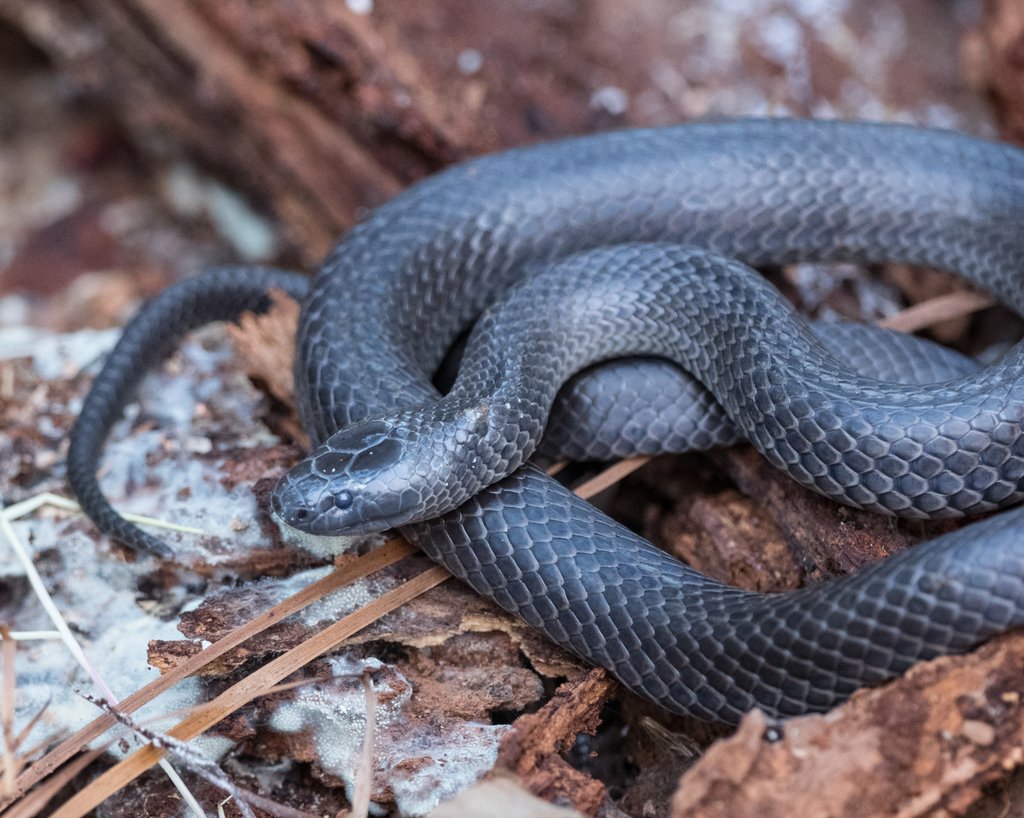Small-eyed Snake
Eastern Small-eyed Snake
May be confused with the closely related Carpentaria Snake Rhinoplocephalus boschmai and the Red-bellied Black Snake Pseudechis porphyriacus; both of which overlap the Small-eyed Snake’s distribution.
Introduction
Though common through its range, you’d be unlikely to encounter this beautiful and secretive night-dweller.
What do Small-eyed Snakes look like?
Identification
A small to moderately-sized species. The head is slightly flattened and barely distinct from the solid body. The back, sides and top of the head and body are steely blue-black. The ventral colour ranges from cream (in the south) to bright coral pink (in the north), and is often flecked or blotched with black. This colouration is confined wholly to the ventral scales and does not show on the lower lateral rows. Scales are smooth and glossy. The eyes are small and darkly coloured.
Midbody scales in 15 rows, ventrals 165-210, anal and subcaudal scales single.

© CC BY-NC-SA 4.0
Where do Small-eyed Snakes live?
Habitat
Small-eyed Snakes are found in mesic (high moisture level) habitats including rainforest and wet sclerophyll forest, as well as woodlands, heaths and rock outcrops. They shelter beneath stones, exfoliated rock, loose bark and fallen timber, and also within rock crevices.
Distribution
Occurs along the coast and mesic hinterland of eastern Australia between northern Cape York Peninsula in Queensland and eastern Victoria.
Biomaps map of Small-eyed Snake specimens in the Australian Museum collection. http://www.biomaps.net.au/biomaps2/mapam.jsp?cqn=Rhinoplocephalus%20nigrescens&cql=sn&csy=Square
Seasonality
During winter in sandstone escarpment country southwest of Sydney, the species brumates inside crevices and under rocks.
What do Small-eyed Snakes eat?
Feeding and diet
In the wild, Small-eyed Snakes eat a wide variety of ectothermic prey including lizard eggs, dragons, legless lizards, skinks, blind snakes, and other small snakes. However, skinks are the predominant prey. One individual has been found with a frog in its mouth, but the fact that no frogs appear in stomach contents raises the question of whether frogs are actually ingested. They may be grasped and then released if found unpalatable.
The species has been interpreted as being an active forager at night, searching for diurnal lizards in their nocturnal sleeping places. This interpretation follows from the fact that Small-eyed Snakes are active on the surface at night while its known prey species are largely diurnal. However, they may also be considered an ambush predator of diurnal lizards temporarily seeking shelter under surface cover during the day, and then moving to a new ambush position by night. It is possible that Small-eyed Snakes are both an active searcher and an ambush predator.

© CC BY-NC 4.0
Reproductive behaviours and adaptations of Small-eyed Snakes
Breeding behaviours
Sexual maturity is attained in males at a snout-vent length of about 263mm in Victoria, 287mm in New South Wales and 298mm in Queensland and in females at about 285mm in Victoria, 300mm in New South Wales and 293mm in Queensland. In Morton National Park south of Sydney, maturity is attained in males at a snout-vent length of about 330mm and in females at about 311mm (at approx. 2-3 years of age).
Male combat has been observed on a bitumen road at night in the first half of spring (October). In Victoria, females can carry enlarged follicles in early spring (September). Gravid females occur over a broad season, from early spring to early autumn (late September to mid-April). Gravid females captured in the wild and brought into captivity gave birth in late summer to early autumn (February-March). The species bears live young (ovoviviparous), with up to 8 young being born (average of 4). In the largest regional sample, that from New South Wales, there was a significant positive correlation between litter size and female size, however, there was no significant correlation in samples from Victoria or Queensland. It would appear that females are able to reproduce yearly.
Other behaviours and adaptations
In the wild, the Small-eyed Snake is usually only found on the surface at night, and under cover during the day. The same daily pattern of activity is also evident in snakes in captivity.
This species may form winter aggregations, with up to 29 individuals being found sheltering together. One study of winter-captured snakes from the sandstone escarpment country southwest of Sydney showed they actively chose artificial shelter sites with narrow crevices and warm temperatures, suggesting these shelter features may be sought by the snakes in nature during winter.
Conservation status
Conservation status
Not listed as threatened.
Predators
The Small-eyed Snake may occasionally fall prey to its own kind (cannibalistic).
Danger to humans
The Small-eyed Snake is very secretive and unlikely to be encountered in the open during the day. When disturbed it may thrash about aggressively, but it is usually disinclined to bite. Toxicity of the venom seems to vary geographically, and the effect on humans can range from no symptoms to renal failure and possibly death (one recorded fatality). The venom contains a long-acting myotoxin that continues to attack muscle tissue (including heart muscle) for days after envenomation. A bite should always be treated as serious and medical attention sought as soon as possible.
Specimen in our collection
View microCT scans of a Small-eyed Snake (Cryptophis nigrescens) from the Australian Museum Herpetology Collection (specimen AM R.201744). Learn more about microCT scanning and how it is used by the Australian Museum Research Institute.
References
- Cogger, H. (2000) “Reptiles and Amphibians of Australia”, Reed New Holland
- Greer, A.E. (2006) “Encyclopedia of Australian Reptiles : Elapidae”, Australian Museum
- Ehmann, H. (1992) “Encyclopedia of Australian Animals : Reptiles”, Australian Museum, Angus & Robertson
- Mirtshin, P. and Davis, R. (1991) “Dangerous Snakes of Australia”, revised edition, Ure Smith Press
- Wilson, S. and Swan, G. (2008) “A Complete Guide to Reptiles of Australia”, Reed New Holland


